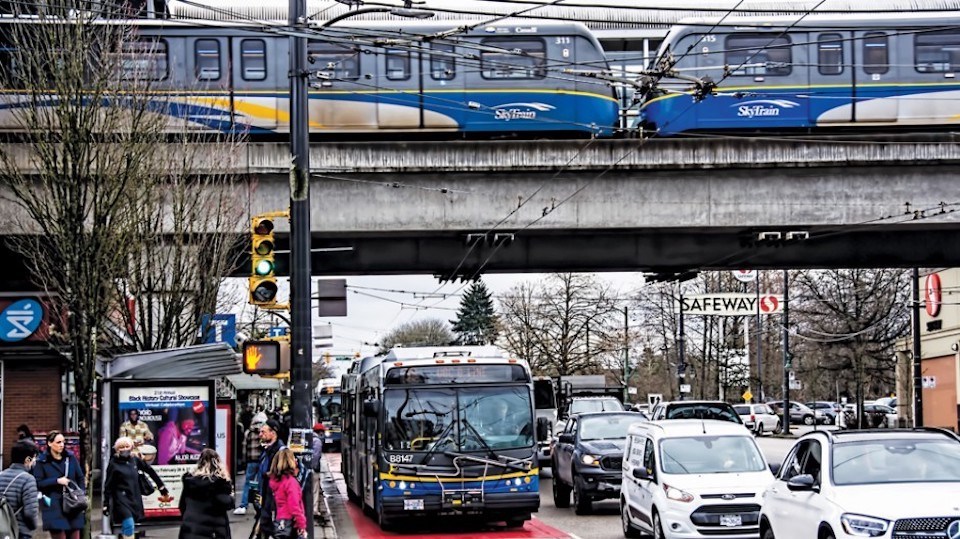“We may need to consider difficult decisions in the future,” TransLink CEO Kevin Quinn said late last month, spelling out his agency’s challenges in frank terms before the region’s Mayors Council.
Revenue is down significantly from pre-pandemic levels with TransLink projecting a $46.9 million deficit for the year. Meanwhile, emergency pandemic funding from government, meant to keep transit services humming along even as fewer people commute to work, is drying up.
And despite the federal government pledging last month an additional $750 million to help cities with any shortfalls in transit revenue, Quinn cautioned that further shortfalls could result in service reductions, stalled expansion plans or cancelled capital projects.
It’s a prospect that could put further pressure on the transit agency as well as some Metro Vancouver workers, as the rapid shift to remote and hybrid working continues to change commuting patterns during the pandemic.
Boardings in February sat at 64.5 per cent of pre-pandemic levels, up from 57 per cent at the end of January when Quinn said the COVID-19 Omicron wave was keeping some riders away. TransLink’s goal is to get ridership up to 80 per cent by the fall through a campaign aimed at attracting former riders as well as through employers and community events.
Peter Hall, an urban studies professor at Simon Fraser University, said it’s unlikely transit patterns will ever return to what was the norm prior to the pandemic.
“I am very concerned about the implications of all of this,” he said.
Hall noted that transit’s big advantage is in high-volume hours when regular commuters journey from home to work as directly as possible. But the rise of remote and hybrid working has disrupted that significantly.
“If people’s commute patterns are going to become more flexible and fluid, and they’re going to change from one week to the next … you can see how people might under those circumstances say, ‘Well, I’m not going to buy a monthly or bimonthly transit pass. I’m going to drive my car two days a week or I’m not going to take transit,’” he said, adding that any excess capacity on the roads is generally filled up quickly as soon as commuters notice traffic levels going down. Commuters with the means to do so will often opt to use their own vehicles rather than take transit.
But with commuting patterns becoming more irregular and transit ridership falling, tech companies have been exploring ways to address those issues.
Vancouver-based Spare Labs Inc. specializes in software that makes it easier for cities and transit agencies to manage transportation networks.
“Our customers, they really realized that they couldn’t just have fixed routes as their only service, because, while it can transport a lot of people, at the same time it’s not very dynamic. It can’t easily change based what’s happening in real life,” CEO Kristoffer Vik Hansen told BIV in November.
He said demand for the company’s technology as surged throughout the course of the pandemic, with the company tripling its number of customers and doubling its headcount, which now stands at 50 workers. And late last year it was able to close a Series A funding round of $18 million.
Spare Labs’ platform allows commuters to punch in their location and find travel options to get to their final destination. In some cities, buses may even be rerouted in real time depending on demand instead of travelling along fixed routes on fixed schedules.
Among the more than 50 cities in which Spare’s made-in-B.C. tech is being used, Dallas Area Rapid Transit plans in the coming weeks to at least double the number of micro-transit zones Spare helps to manage. Micro-transit zones represent the gap between a starting point or end destination (such as a home or workplace) and a major transit hub (a SkyTrain station or bus loop, for example).
In the case of Dallas, the doubling of micro-transit zones means greatly reducing the number of fixed-route buses and replacing them with on-demand options that Spare’s platform can help facilitate for passengers.
Spare has also had conversations with TransLink and BC Transit about introducing its technology to those agencies.
“We’ve seen a really strong surge in demand for this type of service because so many different cities and municipalities are evaluating their current needs when it comes to transit,” said chief operating officer Josh Andrews.
Meanwhile, it’s unlikely employers will ever be able to put the genie back in the model when it comes to working from home, according to Sylvia Fuller, a University of British Columbia professor of sociology specializing in labour.
“Commuting sucks time out of your life,” she said. “It’s often very unpleasant, particularly if you’re driving in rush-hour traffic.”
But she cautioned there might be a temptation from some employers to ask for more, knowing employees don’t have to deal with a long commute into work.
“Is it coming along with increased expectations from employers that if you’re not commuting, maybe you’re going to be more available to me that I can schedule a meeting with you at 7 a.m. instead of 8 a.m.” Fuller said.
“Then we also need to make sure that for those who are still going in and need to work in person, that they’re not … bearing the burden of it, in terms of having fewer resources and supports.”




